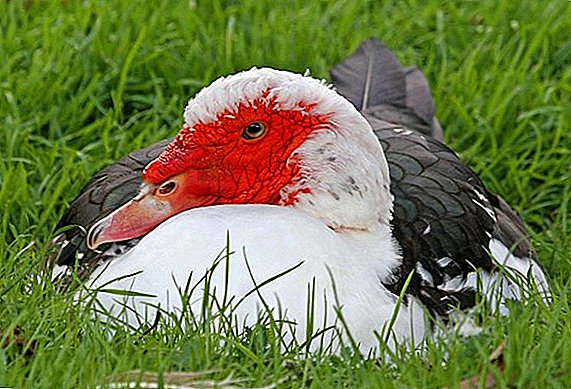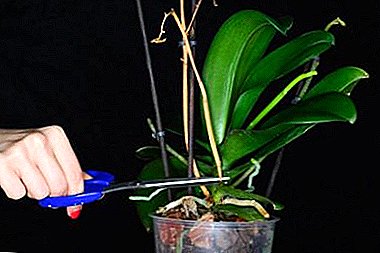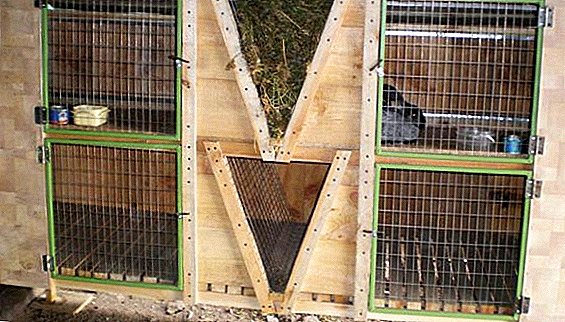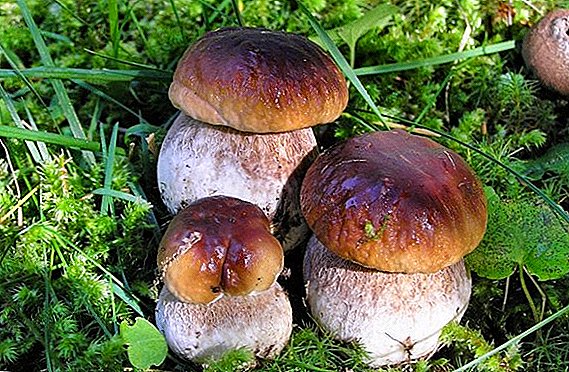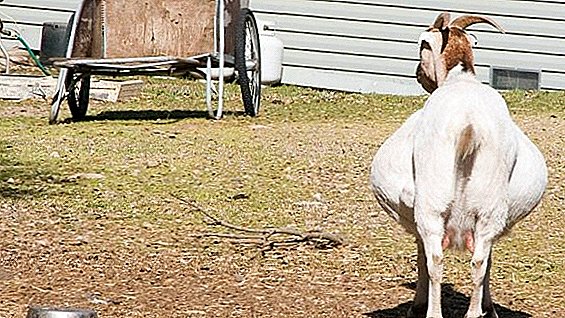 Breeding goats - a troublesome, but profitable and pleasant. Anyone who decided to do this, you must first learn all the nuances of growing these animals. This article focuses on the pregnancy (succinality) of a goat: the signs, duration, and care of animals during this period.
Breeding goats - a troublesome, but profitable and pleasant. Anyone who decided to do this, you must first learn all the nuances of growing these animals. This article focuses on the pregnancy (succinality) of a goat: the signs, duration, and care of animals during this period.
When should goat mating
Goats become sexually mature and begin to experience hunting at 7-8 months, but at this age they do not happen so as not to harm their health and reduce the quality and quantity of milk in the future. The body of a young goat is fully prepared for a mating in 1-1.5 years, when its weight reaches 32-40 kg. If the weight is less than this, the binding must be canceled until the animal gains the permissible mass.

Hunting, or heat, takes place in the cool months (from September to March). The cycle lasts about 3 weeks.
Distinctive signs of goat hunting:
- the animal is restless;
- reacts sharply to odors, including the smell of a goat;
- genitals enlarged and reddened;
- there are vaginal discharge, first turbid, then white.
It is during this period that the male should be brought to the female. Their stay in one pen can last 0.5-4 days.
Did you know? The goat's brain is well developed, so it is easy to train it, if, of course, it is good to treat it.
How to determine pregnancy in a goat
Whether the mating was successful, it is difficult to find out - any visible changes in physique and behavior will be noticeable only in the second half of the term. Nevertheless, it is very important to recognize the gestation period as early as possible so that the animal receives proper care and feeding.
Folk ways
First you need to watch the goat after mating.
She is pregnant if:
- resumed, or even improved milk yield;
- after a 3-week cycle, estrus is not repeated.
In the second half of the term, more obvious signs appear:
- the abdomen is enlarged, the sides are rounded, asymmetry is visible;
- external reproductive organs swell and flatten;
- udder pours, swells;
- the goat behaves calmly, cautious, lies more than walks, appetite does not deteriorate;
- before lambing, the pelvis bones noticeably expand.

To determine pregnancy at an early stage, in addition to observations, you can apply proven popular methods:
- collect morning urine (0.5 cups) and pour baking soda into it (1 tsp.): there will be no hissing reaction during sucking, soda just sinks to the bottom;
- 7-14 days after mating, pipette milk and drop a couple of drops into a glass of water: dry milk (i.e. carrying the fruit) goats will drop to the bottom without dissolving;
- 3 weeks after mating, when the hunt should be repeated, bring the goat again: if the goat has no interest in him, it means that she will soon become a mother;
- after 3 months of pregnancy, make palpation: in a hungry goat with two hands to clasp the stomach, with one hand to press the uterus, and with the other you can palpate the fetus, if it is.
Laboratory methods
Sufficiently high accuracy have scientific methods for determining sukhoznosti. These include tests for progesterone, a pregnancy hormone, the amount of which should increase significantly. The goat breeder can independently check the level of the hormone using special test strips (sold in pet stores), which are used for urine and milk. They can be applied within 2 weeks after mating.
Important! Ultrasound is recommended to use all goat. This analysis shows not only the presence of pregnancy, but also how well it proceeds.
Other laboratory tests are carried out by a veterinarian:
- examination of the cervix with a special sterile mirror is carried out on a 4-week period: the presence of thick cervical mucus confirms syagny;
- analyzes of blood, milk or mucus samples are given 2.5 weeks after the test;
- ultrasound examination with a special device is the most reliable, since it shows the highest percentage of accuracy.
How many months does the pregnancy last
The average duration of a goat pregnancy is approximately 5 months, or 150 days. This period for various reasons may vary between 146-157 days. The duration of suckling is related to the number of babies that are hatched: if a cub is one, the goat wears it longer than the average term, two months - 5 months, and more than two (up to 5 kids) - longer than 150 days.

Care and feeding during pregnancy goats
Having made sure that the goat will soon become a mother, the goat breeder should provide her the best care. For example, it should be kept in a dry warm room, and walking in the open air - only on level ground, without obstacles for jumping (fences, pits). Starting and feeding are very important components of the proper care of the sugary goat.
Starting is the termination of the animal's milking 1.5-2 months before the lambing. This step is necessary so that the goat organism does not give out along with the milk, but accumulates the valuable nutrients necessary for the formation of a healthy fetus and for the health of the expectant mother.
Sometimes, milk yield from a goat decreases naturally. If she continues to generously give milk, it should be run.
Read also how to determine pregnancy in a goat at home.
It is necessary to stop milking gradually, in the following sequence:
- In the 1st week, switch from 3-time milking to 2-time milking.
- In the 4th week - 1-time milking, 1 l of milk each.
- In the 3rd week - hand over 0.5 liters every 1.5 days.
- In the 4th week - 0.3 l every 2 days.
- In the 5th week - only by necessity little by little (1 cup or less).
The need for milking during startup may appear in case of hardening of the udder. Then it is necessary to gently massage it and a little bit.
Throughout pregnancy, the goat must eat well. Food should be as vitaminized as possible, therefore it consists of both combined and green fodder.
Particular attention should be paid to feeding when the goat stops feeding. At this time, changing and diet, and feeding mode. 
Changes in nutrition look like this:
- At the beginning of the launch juicy products (greens, vegetables) are excluded.
- When milk production has stopped, the nutrition is resumed with an increase in the daily portion of the compound feed to 1.5 kg.
- 14 days before delivery, the portion of feed reduced by 2 times.
- 4 days before the lambing again all juicy products are removed from the diet.
After the birth of cubs (in 3-4 days), the mother will again eat the same.
For the health of the syagny goat, it is very important to feed it with high-quality and properly prepared products.
Therefore, you can not give it to:
- spoiled, rotten, moldy hay and vegetables;
- turnips and juicy tops;
- raw root vegetables (potatoes, beets), but only boiled;
- cold water, preferably warm with wheat bran.
Important! Cold water and spoiled foods can cause miscarriages in an animal in the same way as blows and pushes to the stomach.
Goat birth
You can learn about the upcoming birth by the behavior and external changes of the goat:
- she is very restless, then lies down, then rises;
- external reproductive organs swell and expand.
So the animal signals that it is time to prepare for the upcoming event. It will not be superfluous to invite to the birth of a veterinarian. His qualified help will be needed in case of complications.
Room preparation
When signs of fast lambing appear, the expectant mother should be transferred to a separate cell of 2 m² in size, in which there is a trough and a trough. The room should be chosen dry, with good ventilation, but without drafts. Dwellings for goats with kids need to be prepared in advance, about a week.

Preparation includes:
- manure and other debris must be cleaned from the cage;
- for disinfection, whiten walls, floors and surfaces with a solution of lime (1 kg per 10 liters of water) or treat with a solution of formaldehyde (1%), a solution of soda ash (5%) or creolin (5% solution);
- lay on the floor a thick layer of fresh straw.
The air temperature in the goatling should be not less than + 15 ° С, and the humidity should not exceed 75%.
How to take delivery
If the goat is healthy and the birth is correct, then the animal does not need human help. The role of kozovod is to observe the process and be ready to help in case of complications.
Normal delivery in the following order:
- A bubble with a liquid comes out and bursts.
- Then the cub goes forward with the head and front legs.
- After a short time, the next goat goes.
- After 2 or 3 hours after the end of labor goes afterbirth.
Read more about goat lambing and the care of kids.
What should goat:
- each newborn goat, especially the nose and mouth, should be wiped with a clean rag from mucus so that it does not suffocate, and feed the mother;
- in newborns, bandage the umbilical cord with iodized thread 2-3 cm from the tummy, while stepping back another 1 cm, cut off and smear the cut with iodine;
- after the afterbirth, change the dirty litter to a clean litter;
- wash thighs and croup of mother with a solution of baking soda.
Possible problems
There are cases of complicated birth, when the animal can not do without the help of man. If the childbirth takes the novice, he will need qualified assistance from a veterinarian or other experienced nursery.
Possible problems and their solutions are given below:
- The bubble came out, and the kid does not go: wash and sanitize hands, process the vagina with boric petroleum jelly, gently help the fetus out of the hands, tightening it in the direction of the udder during each attempt.
- The fruit is wrong: Veterinary intervention required.
- Last not long: 4 hours after lambing, give a goat to drink warmed wine or a decoction of flax seeds (2 tsp. of seeds should be boiled for 10 minutes in a glass of water). If this does not help, then after 12 hours you should call the vet.
- Goat out in a bubble: you need to get it out of him urgently, otherwise he will suffocate.
- The born cub does not breathe: you must immediately open his mouth and blow into it. If it didn’t work, the baby should be put on his back and, in turn, bend and unbend his legs.
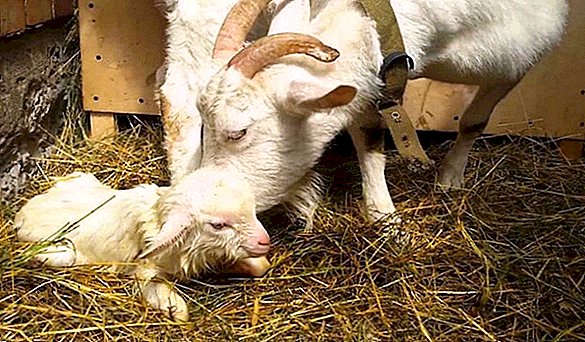
Care for the goat and baby at first
Since the cubs feed on mother's milk, their health and development depend on her well-being, therefore it is important to properly care for the goat. Of particular importance in the postpartum period is the resumption of milking and the feeding regime.
The sequence of stripping after lambing:
- Immediately after the appearance of the kids and before the release of the afterbirth, a little colostrum should be made. Microbes can be present in it, so babies cannot be given it.
- In the 1st week of the goat milked 5 times a day (every 3-4 hours).
- At week 2, 4-time milking is performed.
- For the 3rd week, 3-time standard milking is already practiced.
Did you know? At the World Congress of Pediatricians, which was held in Paris in 1906, goat's milk was declared the best substitute for mother's milk, because it has the most similar composition.
It is important to filter out all the milk. To facilitate the distribution, you can massage the udder with circular movements.
Diet also varies with the recovery period of the goat after lambing:
- Immediately after the end of the lamb, the animal needs to be reinforced: drink warm water and sugar, after 1.5 hours let the water and fresh hay drink again.
- On the 1st day to drink every 3-4 hours.
- The first 4 days 4 meals a day in small portions: easily digestible feed, about 300 g of bran per day (to improve digestion).
- From the 5th day and until the end of feeding the kids, the goat’s daily ration includes such products as: fresh hay (2 kg), tree branches (1 kg), bran (400 g), root crops (3 kg), concentrated feed (500 g) and salt (10 g).
- After the cessation of feeding the cubs with mother's milk, the goat returns to its normal nutritious diet.
Timely recognition of the goat suckering, together with proper care for it before and after lambing, is the key to healthy offspring and good milk yields. Even beginner kozovody can learn all this.




